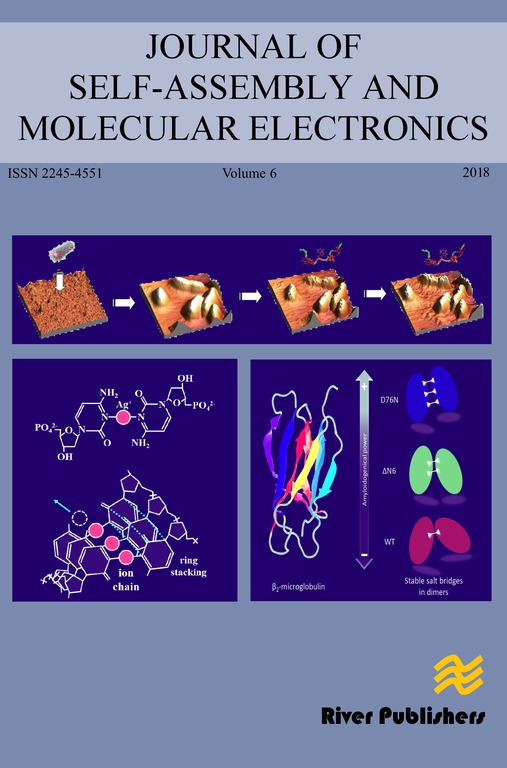Probing the Amyloid Peptide-Membrane Interaction Using a Liposome Model System
DOI:
https://doi.org/10.13052/jsame2245-4551.2016001Abstract
The aggregation of amyloid peptides is closely related to the pathogenesis
of degenerative diseases. More and more evidence implies that the proto
fibrillar intermediates rather than the mature amyloid fibrils are the toxic
species related to the membrane disruption. In this work we found that the
self-assembling intermediates of Aβ33-42 during early aggregation are able
to break down the liposome. During the process of amyloid peptide (Aβ33-42)
intermediate binding to liposome, the β-sheet secondary structure of peptide
took change on the molecular level which was characterized by circular
dichroism (CD) spectra. The small micelles were formed due to the disruption
of amyloid peptide, and further to grow into big irregular complexes with
further incubation, which is characterized by the assay of disrupting liposome
membrane and atomic force microscopy (AFM). This founding paved the way
to understand the interactions between the amyloid peptide and membranes,
and support the amyloid peptide nanostructure formed in the early stage of
aggregation has good affinity with membrane.
Downloads
References
G. G. Glenner, D. Ein, E. D. Eanes, H. A. Bladen, W. Terry and
D. L. Page. Science, 174, 712–714 (1971).
G. G. Glenner, N. Engl. J. Med. 302, 1333–1343 (1980).
G. G. Glenner and C. W. Wong. Biochem. Biophys. Res. Commun., 120,
–890 (1984).
D. J. Selkoe. Nature, 426, 900–904 (2003).
M. P. Lambert, A. K. Barlow, B. A. Chromy, C. Edwards, R. Freed,
M. Liosatos, T. E. Morgan, I. Rozovsky, B. Trommer, K. L. Viola, P. Wals,
C. Zhang, C. E. Finch, G. A. Krafft and W. L. Klein. Proc. Nat. Acad.
Sci. U.S.A., 95, 6448–6453 (1998).
H. A. Lashuel, D. Hartley, B. M. Petre, T. Walz and P. T. Lansbury.
Nature, 418, 291–291 (2002).
M. Fandrich, M. A. Fletcher and C. M. Dobson. Nature, 410, 165–166
(2001).
C. M. Dobson. Philos. Trans. R. Soc. Lond. B Biol. Sci., 356, 133–145
(2001).
E. D. Roberson and L. Mucke. Science, 314, 781–784 (2006).
M. Goedert and M. G. Spillantini. Science, 314, 777–781 (2006).
A. Lorenzo, B. Razzaboni, G. C. Weir and B. A. Yankner. Nature, 368,
–760 (1994).
W. Dauer and S. Przedborski. Neuron, 39, 889–909 (2003).
T. M. Dawson and V. L. Dawson. Science, 302, 819–822 (2003).
R. Kayed, Y. Sokolov, B. Edmonds, T. M. McIntire, S. C. Milton,
J. E. Hall and C. G. Glabe. J. Biol. Chem., 279, 46363–46366 (2004).
Y. Sokolov, J.A. Kozak, R. Kayed,A. Chanturiya, C. Glabe and J. E. Hall.
J. Gen. Physiol., 128, 637–647 (2006).
W. L. Klein. Neurochem. Int., 41, 345–352 (2002).
L. Tao et al.
A. Quist, L. Doudevski, H. Lin, R. Azimova, D. Ng, B. Frangione,
B. Kagan, J. Ghiso and R. Lal. Proc. Nat. Acad. Sci. U.S.A., 102,
–10432 (2005).
S. M. Butterfield and H. A. Lashuel. Angewand. Int. Edn., 49, 5628–5654
(2010).
D. L. Brody, S. Magnoni, K. E. Schwetye, M. L. Spinner, T. J. Esparza,
N. Stocchetti, G. J. Zipfel and D. M. Holtzman. Science, 321, 1221–1224
(2008).
E. Mikros, D. Benaki, E. Humpfer, M. Spraul, S. Loukas,
C. I. Stassinopoulou and M. Pelecanou. Angewand. Int. Edn., 40,
–+ (2001).
M. S. R. Shearman, C. I. Ragan and L. L. Iversen. Proc. Natl. Acad. Sci.
U.S.A. 91, 1470–1474 (1994).
L. Liu, L. Zhang, L. Niu, M. Xu, X. B. Mao, Y. L. Yang and C. Wang.
AcsNano, 5, 6001–6007 (2011).
J. Herms, C. Priller, T. Bauer, G. Mitteregger, B. Krebs and
H. A. Kretzschmar. J. Neurosci., 26, 7212–7221 (2006).
D. J. Selkoe, Trends Neurosci., 16, 403–409 (1993).
L. Liu, L. Zhang, X. B. Mao, L. Niu, Y. L. Yang and C. Wang. Nano
Lett., 9, 4066–4072 (2009).
L. Liu, L. Niu, M. Xu, Q. S. Han, H. Y. Duan, M. D. Dong,
F. Besenbacher, C. Wang and Y. L. Yang. AcsNano, 8, 9503–9510
(2014).



